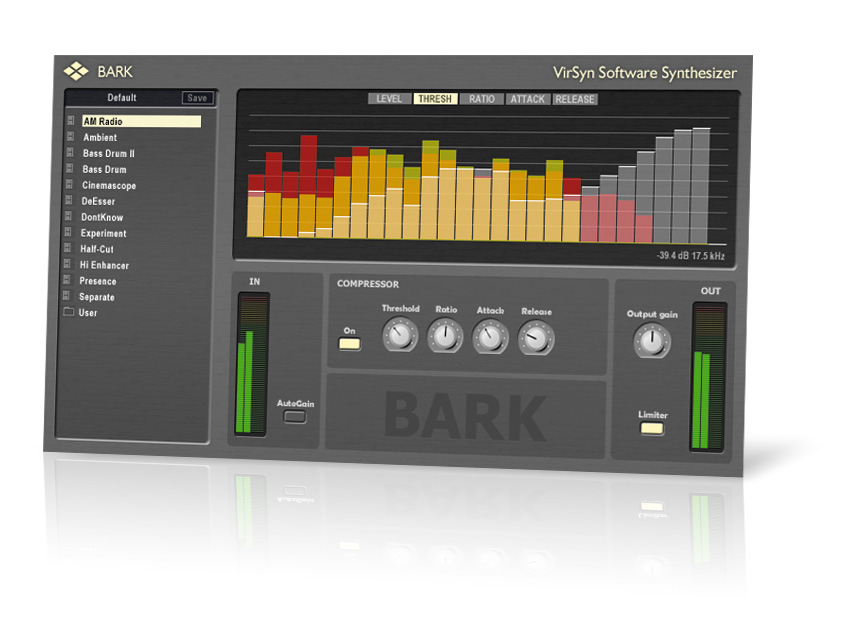MusicRadar Verdict
An unusual effect, and one that's not to be confused with your average multi-band compressor.
Pros
- +
Effects go from subtle to dramatic. Easy-to-grasp GUI, with good metering. Offers EQ and compression. Surround-ready.
Cons
- -
A specialist effect. Fixed frequency bands. Pokey display.
MusicRadar's got your back
VirSyn has a habit of producing useful plug-ins with a slightly esoteric twist. For its latest endeavour, Bark, it's gone for a linear-phase multi-band dynamic filter.
The twist, though, is that the bands used are designed to match the so-called 'critical frequencies' of human hearing.
The plug-in takes its name from the Bark scale, a psychoacoustic measurement system proposed by Eberhard Zicker, who named it after the renowned German physicist Heinrich Barkhausen.
The scale has 24 bands (or Barks), which represent the first 24 critical bands of human hearing. In essence, these are the overlapping band-pass or 'auditory' filters present in our hearing system.
So why is this significant? Well, the bands themselves affect our ability to distinguish different pitches. In simple terms, two sounds falling within the same critical band can create a 'masking' effect, whereby one signal seriously affects our perception of the other. If they fall into different critical bands, this doesn't happen.
Furthermore, this aural phenomenon greatly affects our concepts of musical pitch, particularly the detection of both consonance and dissonance.
That's the science, but what does it mean in practice?
Want all the hottest music and gear news, reviews, deals, features and more, direct to your inbox? Sign up here.
Overview
To be honest, Bark couldn't be much simpler. The centre frequencies of the 27 bands range from 50Hz to 17.5kHz, and graphic EQ-style tweaking of the levels of each is carried out from the main display.
However, this being a dynamic EQ, there are also 27 bands of compression, with the main section in the middle governing overall settings via four familiar knobs: Threshold, Ratio, Attack and Release. There are also tabs for each of these parameters, so it's possible to make per-band changes with the vertical sliders.
The AutoGain feature is handy, applying make-up gain on a band-by-band basis to match the corresponding reduction. There's a limiter on the output too, which is standard fare but useful, given the potential 40dB of output gain.
Finally, like all good dynamics processors, you can link or unlink the left and right channels. But as Bark is capable of multi-channel processing with fully flexible linking, it could hold its own in the world of surround mixing, too.
One significant aspect of the plug-in's design is that the filters have quite sharp profiles, and when taking into account the non-colouring linear-phase design, we were expecting Bark to be more 'function' than 'funk'. But the +24/-48dB gain range per band, combined with the easy-access interface, meant that we were happily mangling our sounds right from the off. The results can be somewhat bombastic, but a good equaliser or compressor always delivers when placed under strain, and Bark definitely falls into that category.
If you push the EQ levels right up, though, the sharpness of the filters becomes obvious, with a sort of 'ringing' timbre that could be put to good creative use. VirSyn's use of the Bark scale means that the frequencies are set in stone, though, and you could find this annoying.
Visually, Bark is right on the money, with each slider on the interface doubling as a meter, showing the signal level (orange), gain reduction (red) and gain increase (green), with manual boosts or cuts indicated, too. On the downside, the display isn't the largest, although there is a Fine mode that zooms the resolution to +/-12dB.
Summary
Thanks to VirSyn's 'scientific' design ethos, we were expecting Bark to be polite, but it's the opposite. That's not to say it's incapable of subtlety - it just lends itself to bold, creative applications. This is an interesting addition to VirSyn's effects range, and it's well worth taking the demo for a spin if you've got a Syncrosoft dongle.
Hear what Bark can do to drums, piano and strings:
Computer Music magazine is the world’s best selling publication dedicated solely to making great music with your Mac or PC computer. Each issue it brings its lucky readers the best in cutting-edge tutorials, need-to-know, expert software reviews and even all the tools you actually need to make great music today, courtesy of our legendary CM Plugin Suite.

